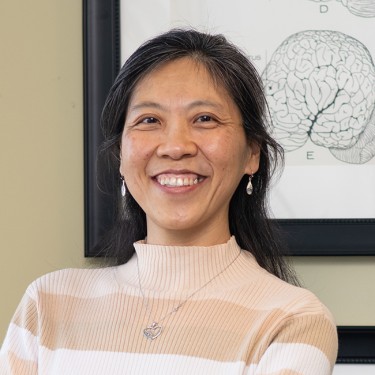Ling Cao
Education
- M.D., Clinical Medicine, Beijing Medical University (Currently Peking University Health Science Center), 1997
- Ph.D., Toxicology, SUNY Albany, 2002
Brief Biography
Dr. Ling Cao is a professor of immunology in the Department of Biomedical Sciences, University of New England College of Osteopathic Medicine, and the current chair for UNE’s institutional Animal Care and Use Committee (IACUC). Dr. Cao’s research focuses on chronic pain. In the laboratory, her laboratory investigates the neuroimmune mechanisms of neuropathic pain using rodent models, including peripheral injury induced neuropathic pain and HIV-associated peripheral neuropathy. She also conducts secondary data analysis and human subject research trying to understand factors affecting the chronic pain and its management. The goal of her research is to help bridge basic research with clinic practice. Her lab has also been active in mentoring students in various disciplines who are interested in participating in research.
Dr. Cao received training in Clinical medicine from the Beijing Medical University (Currently Peking University Health Science Center) and earned her Ph.D. in Toxicology from SUNY Albany. She completed her post-doctoral training at the University of Rochester School of Medicine and Dentistry and the Dartmouth Geisel School of Medicine. Dr. Cao became a faculty member at UNE COM since 2007.
Research Interests
- Behavioral/Cognitive Sciences
- Bioinformatics/Computational Biology
- Immunology / Inflammation / Hematology
- Molecular and Cellular Biology
- Neuroscience
- Medical education research
Postdoctoral Training
Post-Doctoral Training, Neuroimmunology
Dartmouth College (Lebanon, New Hampshire)
Post-Doctoral Training, Psychoneuroimmunology
University of Rochester (Rochester, New York)
Selected Publications
Please view the complete list of our publications through the following link:
http://www.ncbi.nlm.nih.gov/myncbi/ling.cao.1/bibliography/46382587/public/?sort=date&direction=ascending
- L. Cao, L. Fei, T. T. Chang, and J. A. DeLeo. 2007. Further induction of IL-1beta by IL-4 in LPS-treated mixed glial cultures. Journal of Neurochemistry 102(2), 408-419.
- C. A. Hudson, G. P. Christophi, L. Cao, R. C. Gruber and P. T. Massa. 2007. Regulation of avoidant behaviors and pain by the anti-inflammatory tyrosine phosphatase SHP-1. Neuron Glia Biology 2 (4), 235-246.
- I. D. Meng and L. Cao. 2007. From migraine to chronic daily headache: the biological basis of headache transformation (Invited review). Headache 47(8), 1251-1258.
- L. Cao and J. A. DeLeo. 2008. CNS infiltrating CD4+ T lymphocytes contribute to murine spinal nerve transection-induced neuropathic pain. European Journal of Immunology 38, 448-458 (featured “In This Issue”). (PMCID: PMC2963094)
- L. Cao, F.Y. Tanga and J. A. DeLeo. 2009. The contributing role of CD14 in Toll-Like receptor 4 dependent neuropathic pain. Neuroscience 158(2), 896-903. (PMCID: PMC2701510)
- L. Cao, C. D. Palmer, J. T. Malon and J. A. DeLeo. 2009. Critical role of microglial CD40 in the maintenance of mechanical hypersensitivityin a murine model of neuropathic pain. European Journal of Immunology 39, 3562-3569. (PMCID: PMC2810130)
- J. T. Malon, S. Maddula, H. Bell and L. Cao. 2012. Involvement of calcitonin gene-related peptide and CCL2 production in CD40-mediated behavioral hypersensitivity in a model of neuropathic pain. Neuron Glia Biology (Mar 1:1-12; published online).(PMCID: PMC4110723)
- L. Cao, M. B. Butler, L. Tan and K. S. Draleau. 2012. A murine immunodeficiency virus induced peripheral neuropathy and associated cytokine responses. Journal of Immunology 189(7), 3724-33. (PMCID: PMC3448875).
- L. Cao, H. Beaulac, and A. Eurich. 2012. Differential lumbar spinal cord responses among wild type, CD4 knockout, and CD40 knockout mice in spinal nerve L5 transection-induced neuropathic pain. Molecular pain 8(1), 88. (PMCID: PMC3545955)
- L. Cao and M. B. Butler. 2013. Involvement of microglial CD40 in murine retrovirus-induced peripheral neuropathy. Journal of Neuroimmunology 261, 37-43. (PMCID: PMC3729793)
- K. S. Draleau, S. Maddula, A. Slaiby, N. Nutile-McMenemy, J. A. DeLeo, and L. Cao. 2014. Phenotypic identification of spinal cord-infiltrating CD4+ T lymphocytes in a murine model of neuropathic pain. Journal of Pain and Relief S3:003. Doi: 10.4172/2167-0846.S3-003 (PMCID: PMC4136538)
- V. D. McLane, L. Cao, and C. L. Willis. 2014. Morphine increases hippocampal viral load and suppresses frontal lobe cytokine expression in the LP-BM5 AIDS model. Journal of Neuroimmunology 269(1), 44-51. (PMCID:PMC4026271)
- J. Malon, E. Grlickova-Duzevik, J. Vaughn, T. R. Vunk, and L. Cao. 2015. Microglial Content-Dependent Inhibitory Effects of Calcitonin Gene-Related Peptide (CGRP) on Murine Retroviral Infection of Glial Cells. Journal of Neuroimmunology 279(1), 64-70. (PMCID: PMC4325278)
- J. Malon and L. Cao. 2016. Calcitonin gene-related peptide contributes to peripheral nerve injury-induced mechanical hypersensitivity through CCL5 and p38 pathways. Journal of Neuroimmunology 297,68-75. (PMCID: PMC4940993)
- J. Malon and L. Cao. 2016. Preparation of primary mixed glial cultures from adult mouse spinal cord tissue. Journal of Visulized Experiments. Nov 19;(117). doi: 10.3791/54801. (PMCID: PMC5153361.
Complete List of Published Work in My Bibliography.
If you have had GSBSE students who have graduated, can you share names and tell us what they are doing now?
Virginia McLane (2016): Pharmaceutical company after post-doc training
Eliza Grlickova-Duzevik (2017): Assistant Clinical Professor at UNE

